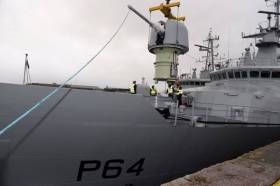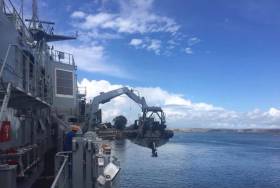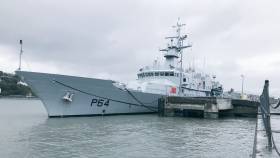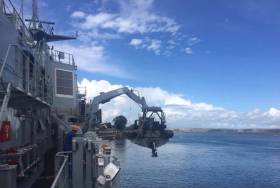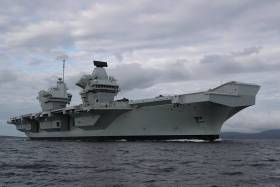Displaying items by tag: LE George Bernard Shaw
Military Fit-Out Sees Primary Armament Take Shape On Board LÉ George Bernard Shaw
#NavalService - Completion towards the Irish Naval Service newest OPV90 P60 class, LÉ George Bernard Shaw took a notable step forward this week with installation of primary armament at the newbuild's homeport in Cork Harbour, writes Jehan Ashmore.
Crane operations saw the 76mm Oto Melara gun hoisted onto the €67m Offshore Patrol Vessel newbuild (P64) LÉ George Bernard Shaw (that arrived in October) to the Naval Service base on Haulbowline Island. The location is shared with the former East Tip, legacy of the closed (west based) Irish Steel Plant, where waste by-products were transferred for dumping. The site however, as Afloat reported has undergone major remediation works, with plans subject to approval to open a new public park in 2019 (adjacent to the Naval Basin) where the fleet moor up in between patrol duties.
It was within the Naval Basin is where the crane completed its role in lowering the Oto Melara gun carefully into position of the cradle on the bow of LÉ George Bernard Shaw. Oto Melara is a subsidiary of Italian defence manufacturer, Finmeccanica S.p.A. who also supplied the main armoury featured on the trio of P60 class sisters. Likewise of the newbuild, they too were all built in recent years by Babcock Marine in north Devon.
The trio of P60's that cost €199.4m form a particular stage of the vessel replacement modernisation programme within the fleet so far, comprising leadship (P61) LÉ Samuel Beckett commissioned in 2014, (P62) LÉ James Joyce in 2015 and (P63) LÉ William Butler Yeats that entered service in 2016.
According to the Naval Service, work remains on the (P64) LÉ George Bernard Shaw, which is to take place over the coming weeks. This is where the Naval Ordnance Section is tasked to integrate the weapon with the ship's systems as the 2,250 tonnes OPV newbuild works up to Full Operational Capability.
Accommodation of the fourth P60 class is for a crew compliment of 44 personnel and berths though provision in the design also caters for an additional 10 trainees required during particular mission deployments.
As for the naming ceremony of LÉ George Bernard Shaw, coupled with an official commissioning into the Naval Service, Afloat will have more to report as developments take shape likewise of the recent external appearance of the P60 that now looks the part.
UK Appledore Shipyard to Shut Putting 200 Jobs at Risk
#Ports&Shipping- The UK shipyard (that built LÉ George Bernard Shaw) is to shut despite its owner being offered a £60m contract by the MoD.
Staff at Appledore Shipyard in Devon reports BBC News have been told by owner Babcock that it will close by the end of March 2019.
The company recently lost a contract with the Armed Forces of Malta, causing financial difficulties.
Babcock said all 199 workers will be offered a move to Devonport Dockyard, also owned by the firm, 45 miles (72km) away.
'We want answers'
The GMB union said it wanted answers from the government and from Babcock about the £60m package which would have offered extra work at Devonport.
Babcock had said the extra work would not be enough to secure Appledore's future, see related report.
Some Appledore staff had been temporarily redeployed to Devonport since the news of the lost contract came through.
For more on "Save Appledore Shipyard" petition and a brief history of the facility dating to 1855, click here.
Could Mystery Boatman Steer Appledore, Devon Shipyard's Future
#Ports&Shipping - A mystery that has got the City's of London's defence and industry experts speculating: just who is behind Boatman Capital Research?
As Sky News reports, Boatman last week published a damning report on Babcock, the engineering services group, which is credited with knocking £130m - or 4% - from the company's stock market valuation.
Its opening paragraph says: "Our investigative team has been researching Babcock for the past six months.
"We have reviewed hundreds of pages of company accounts, government documents and have interviewed numerous sources in the defence sector.
"In our opinion, Babcock has systematically misled investors by burying bad news about its performance.
"We believe that Babcock's senior leadership team - specifically the chairman and chief executive - are not up to the job and their failings will damage the company's future prospects."
For much more on the uncertain future that awaits the West Country shipyard dating to 1855 (click here)
Afloat adds in much more recent times the yard on the River Torridge near Bideford built for the Irish Naval Service, the OPV80/P50 'Roisin' class pair LÉ Roisin in 1999 and two years later LÉ Niamh. This took place when the yard was under ownership of Appledore Shipbuilders, a subsidiary of Langham Industries.
Other orders for Irish interests included Arklow Shipping, when the facility built a pair of bulk-carriers during the early 1990's. The sisters each 7,182dwt, Arklow Brook and Arklow Bridge were sold in recent years as previously reported in Ports & Shipping news.
Plus Appledore constructed the current Shannon Ferries operated double-ended car-ferries, Shannon Dolphin in 1995 and larger half-sister Shannon Breeze in 2000.
Naval Service Latest Newbuild LÉ George Bernard Shaw Makes Delivery Voyage to Cork Harbour
#NavalService - The newest Irish Naval Service Offshore Patrol Vessel (OPV) LÉ George Bernard Shaw completed a delivery voyage from a UK shipyard to Cork Harbour, writes Jehan Ashmore.
Minister with responsibility for Defence, Mr Paul Kehoe TD, welcomed the arrival of LÉ George Bernard Shaw to the Naval Base in Haulbowline on Thursday. Commenting on the arrival, Minister Kehoe said it demonstrates the Government’s commitment to ongoing investment in the Defence Forces. “In Budget 2019, we have committed to spend an additional €29m on capital projects”
LÉ George Bernard Shaw was built by Babcock Marine's Shipbuilding Yard in Appledore, north Devon, England from where as Afloat previously reported the OPV90 carried out sea-acceptance trails in the Bristol Channel. The trials completed successfully, were attended by representatives from the Department of the Defence and the Defence Forces.
The delivery of LÉ George Bernard Shaw to Cork Harbour completes the current Naval Service ship replacement programme of four new OPV90/P60 class vessels since 2014. The class also dubbed the 'Playwright' sisters, began with leadship LÉ Samuel Beckett in 2014, LÉ James Joyce in 2015 and LÉ William Butler Yeats entering service in 2016. The value of the three-ship contract was €199.4m.
In June 2016 an agreement was reached with Babcock International for the provision of an additional OPV90/P60 to be built also at their Appledore shipyard. The agreed contract value for the further ship is €67m inclusive of VAT. This aligns with the project planning process in place under the White Paper on Defence, which will determine the Defence Organisation’s maritime capability requirements.
The LÉ George Bernard Shaw represents six of the current Irish Naval Service fleet having been built in Appledore.The new OPV will be formally named and commissioned as LÉ George Bernard Shaw at a later date.
The Minister said "The addition of the new ship will bring relief to older vessels and support a planned programme of refit and maintenance. LÉ Roisin and LÉ Niamh will receive significant mid-life refits in the period ahead.”
In recent weeks the issues of low-pay, coupled with staff shortage have been raised. In response Minister Kehoe said the Department will continue to work closely with military management to address challenges in the Naval Service.
“The current strength of the Naval Service is just over 1,000 personnel and is at approximately 92% of its establishment of 1,094. There is ongoing recruitment to the Naval Service. Any challenges in delivering the full outputs across the Defence Forces are being managed and closely monitored by the Defence Forces and the Department of Defence under my direction on a daily basis.”
Naval Service's Latest P60 Class Newbuild George Bernard Shaw On Sea-Trials in Bristol Channel
#NavalService - Afloat has tracked the Irish Naval Service's latest offshore patrol vessel carry out sea-trials which involved the €67m newbuild in the Bristol Channel while off the north Devon coast from where the ship was built, writes Jehan Ashmore.
The newbuild George Bernard Shaw is the fourth sister of the P60 class built in the UK yard of Babcock Marine & Technology in Appledore from where the OPV90 ship yesterday evening departed for sea-trials. The shipyard (see previous report) is located close to Bideford on the River Torridge. The facility is also where a previous generation belonging to a pair of P50 class were completed. These smaller OPV80 sisters (the figure referring to the hull length) were built at the same site of the Babcock shipyard albeit then run by Appledore Shipbuilders.
The sea-trial saw the 23-knot capable P60 newbuild head as far west offshore of Hartland Point and later to the east but approach much closer to the shore off Illfracombe. Following these manouveres the 90m newbuild headed further west involving a figure of eight loop when off Lundy Island, before returning to the Bristol Channel.
At 2,250 tonnes the P60 class newbuild, likewise of sisters form the largest in tonnage terms in the navel fleet. The newbuild comes equipped with a comprehensive command, control and communications package while the main weapon consists of a 76mm bow-mounted gun. Installation of the gun as previously reported will be fitted later this year at the Irish Naval Service base located in Cork Harbour.
As for a delivery date to the Naval Service, this is subject to the completion of successful sea trails before a voyage can be made to the Naval Base on Haulbowline Island opposite Cobh.
The OPV by then in Irish waters will be formally named 'L.E. George Bernard Shaw' and commissioned into the Irish Naval Service.
#Navy - The latest Irish Naval Service newbuild, LÉ George Bernard Shaw was floated-out for the first time from a UK shipyard, writes Jehan Ashmore.
LÉ George Bernard Shaw costing €67m, is the fourth of the offshore patrol vessel (OPV90 / 'Samuel Beckett') class sisters to be built by Babcock Marine & Technology shipyard in Appledore, north Devon. The shipyard group which has several facilities throughout the UK won the contract to build the vessel last year.
The OPV was towed by the stern from the building hall in Bidna on the Torridge Estuary near Bideford. The operation which took place last Friday involved the 90 metre newbuild to be towed to the yard's fitting-out quay which was completed as daylight appeared.
Following sea trials the 2,256 tonnes LÉ George Bernard Shaw which will have a crew of 44, is due to be handed over to the INS later this summer.
The Naval Base on Haubowline Island in lower Cork Harbour is where LÉ George Bernard Shaw will join fleetmates, among them LÉ William Butler Yeats. This is the last sister completed by Babcock and Afloat has drone footage capturing the carefull berthing of the OPV at her homeport with the aid of a tug.
A pennant number of (P64) adorns the bows of the sleek looking LÉ George Bernard Shaw which was named in honour of the Irish playright at a keel-laying ceremony last year.
The newbuild follows sisters all named after fellow literary giants: the leadship LÉ Samuel Beckett delivered in 2014, LÉ James Joyce in 2015 and the last to enter service the aforementioned LÉ William Butler Yeats which was commissioned in 2016.
The new patrol vessel will have a comprehensive command, control and communications package along with a main weapon of a bow-mounted 76mm gun. At the time of the float-out this armament had yet to be fitted in addition the mainmast (lying on the fit-out quayside) had yet to be installed.
As for speed the twin-screw OPV will reach 23 knots and a 6,000 miles range is based on a cruising speed of 15 knots. Accommodation for the 44 crew will also cater for an additional 10 trainee berths.
A suite of three rigid inflatable boats on board will serve a variety of tasks for the LÉ George Bernard Shaw which will be able to act as a mother ship.
When LÉ George Bernard Shaw is commissioned into service, the OPV will become the sixth OPV built ship for the current INS fleet. The introduction of the 'Playrights' is part of a vessel replacement /modernisation programme that has seen all of the ageing 'Emer' class OPV's disposed in recent years.
The rest of the fleet comprises of a pair OPV80 class offshore patrol vessels, two coastal patrol vessels and a single helicopter patrol vessel.
Shipyard Where LÉ George Bernard Shaw Is Under Construction Contributed to Building UK's Royal Navy's Largest Ship to be Commissioned Today
#GBShaw/QE – The shipyard currently constructing an Irish Naval Service OPV, also contributed in building the UK’s Royal Navy’s largest warship, HMS Queen Elizabeth, an aircraft carrier that is to be commissioned into service at 12 noon today, writes Jehan Ashmore.
The Naval Service's fourth OPV90 class newbuild to be named LÉ George Bernard Shaw costing €67m is been built at Babcock Marine & Technology’s yard in Appledore, north Devon. The OPV is scheduled to enter service in 2019. The same shipyard also constructed modular sections as part of six UK shipyards involved in the Aircraft Carrier Alliance (ACA) that were assembled in Babcock's yard in Rosyth, Scotland where the giant 65,000 tonnes flagship aircraft carrier was completed earlier this year. The vessel is the largest ever surface warship in the Royal Navy's history.
In Portsmouth Naval Dockyard Base today is where the commissioning ceremony will be attended by Queen Elizabeth II. A live televised broadcast begins at 12 noon today on BBC Newsroom Live (BBC News Channel and BBC2).
Last month Afloat monitored the HMS Queen Elizabeth that has a crew of 700, conduct trials in the Bristol Channel while off the north Devon coast. The overall crew complement total will more than double when aircraft personnel join from fighter jets and helicopters.
The leadship is the first of a pair of QEII class aircraft carriers in which the second newbuild, HMS Prince of Wales is under construction also in Rosyth. There has been criticism of the £6.2 billion cost overruns for both carriers and in the delay of F-35 aircraft jets from US manufacturers. The HMS Queen Elizabeth due to training reasons will not be fully operational until 2021 and as for the sistership this will be in 2023.
Another connection with Scottish shipbuilding but not on the Fife was the launch last month on the Clyde of the Glen Sannox, the first of a pair of ‘Green’ hybrid sister car-ferries for operator CalMac. They are the world’s first liquified gas duel (LNG) marine diesel fuelled ferries. Glen Sannox was scheduled to enter service on the busy Ardrossan-Brodrick, Isle of Arran route (see voyage report) in summer 2018.
The second sister is due to run on the Skye to Harris route, however last month according to The Herald, the newbuilds are experiencing technical issues at Fergusan Marine Engineering Ltd and are now not expected to enter service until 2019 or even 2020.
The FMEL shipyard at Port Glasgow, which was saved from closing in recent years is undergoing a £12m redevelopment on the banks of the Clyde.


























